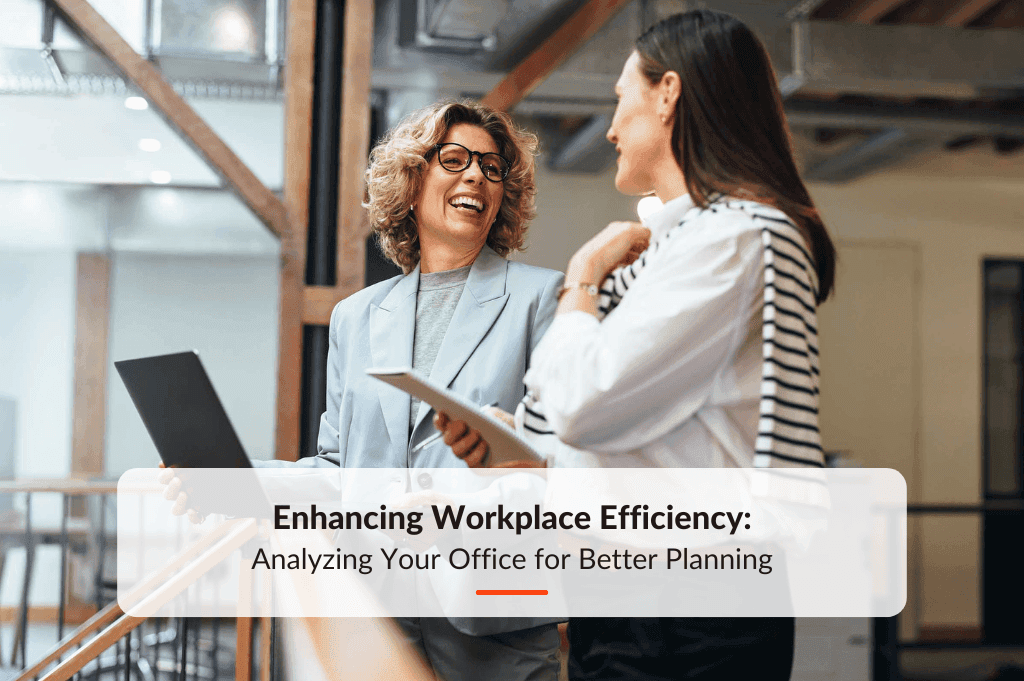The office building serves as the flagship of any business. It attracts top talent and invites potential customers to a welcoming and stylish environment. Interior designers are usually involved early in the process to select the right lamps and furniture, but exclusive Herman Miller chairs can only take you so far. Without a workplace analysis, your new office may lack critical features that can decrease productivity and creativity in the workplace. The success of a company is closely tied to its office layout. We'll tell you why in a heartbeat.
What is workplace analysis?
Are you looking to design an office where people love to spend time? A workplace analysis is necessary for all companies that want to plan and create optimal workspaces. Workplace analysis can be conducted using the following methods: quantitative and qualitative data. The goal is to consider various aspects before making any changes in the office.
Qualitative analysis involves examining the workplace from a 360-degree perspective and taking the existing layout into account. Begin by creating an overview of the office building and layout to identify areas for potential improvement. We recommend starting by mapping out the current floor plans, including doors, passages, windows, and furniture. Here are some examples to consider when assessing the situation:
- The number of windows and the placement of desks
- Narrow spaces that tend to become crowded easily
- Access to bathrooms and break rooms
- The balance between open and closed spaces
- Areas that are difficult to access
- Various types of seating
- Entryways and exits
- Access to well-lit areas
- Different types of storage rooms
The fundamentals of interior design are quite simple, but not always easy to execute. In an office building, there are, of course, limitations. Creating spacious and well-lit areas can be challenging when there are few windows and narrow corridors. Fortunately, there are innovative solutions available, such as installing glass walls or using artificial lighting.
Analyzing the workplace: interviewing workers and management
Another valuable source of information when analyzing the workplace is the employees themselves, as they are the ones who spend the majority of their time in the office. Following the pandemic, people have become accustomed to working from home. Space managers should be aware that employees now view their office environment from a new perspective. People have grown accustomed to the comforts of home and now expect higher standards in the physical office.
There are various methods for collecting employee feedback. Initially, holding a general meeting is a great way to solicit their input and begin planning the office layout accordingly. Another effective approach is to distribute surveys to obtain more accurate and in-depth responses. Surveys provide individuals with the opportunity to share their honest opinions and not succumb to peer pressure.
Your analysis can also benefit from input from other managers. For instance, if you are a space manager, consider seeking feedback from the office manager. He or she can provide valuable information about different security measures such as alarms, sensors, and emergency exits.
Take the opportunity to ask the cleaning staff for their thoughts on the existing layout. Is it easy for them to clean surfaces and move their equipment between floors? Optimizing the building's maintenance will make it easier to adhere to hygiene protocols and create a safer working environment.
We also recommend reviewing past reports. Have there been any previous issues related to security and maintenance? This will help you avoid repeating any past problems.
In summary, anyone with insight into daily operations is useful when it comes to analyzing the workplace. Both form and function should be taken into consideration.
Gathering and understanding data
In recent times, space managers have come to recognize the potential of workplace analytics, enabling them to make data-driven decisions. Through the deployment of sensors mounted on ceilings and under desks, data is collected using workplace analytics software. Real-time and historical data can be easily compared and analyzed, eliminating the need for guesswork.
This kind of data elevates the decision-making process to a whole new level. When you can present the facts, founders and CEOs are more inclined to embrace your solutions.
Creating smarter workspaces
When it comes to improving the workplace, a proper analysis is your go-to solution. Lay the foundation properly before you begin work and create the ideal office.
One of the priorities is to right-size the office to ensure that there are enough desks for everyone working in the office. It becomes easier to adhere to a budget when all the space is utilized, and unnecessary overhead costs are minimized.
Enhancing employee satisfaction
Another priority is to ensure that there are enough collaborative spaces in the office, such as meeting rooms, where team members can work on specific tasks. Open spaces allow people from different departments to come together and exchange ideas. When the office spaces meet employees' expectations, they feel motivated, and retention rates will increase.
Why is workplace analysis valuable for your business?
Due to the digital transformation, society is changing faster than ever, and this change is also reflected in the way we work. With workplace analysis, you will always be able to plan ahead. A properly sized and well-maintained office creates an inspiring working environment and enhances productivity.
Seeking guidance on how to set up your hybrid office for success?
Don't hesitate to schedule a meeting with one of our product experts. They can provide valuable insights into our solutions and how technology can help streamline your office processes without disrupting employees' daily work.
Read more from our blog
- Understanding the hybrid work model: What is hot desking policy?
- What is a hybrid workforce
- Gear up for Teamwork: Strategies for Balancing In-Office and Remote Collaboration
- Is the new office layout worth it? Measure your workplace ROI
- How to right-size your office space: learn more about space planning
